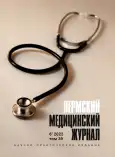Risk factors of maternal and failed maternal mortality, prediction of severe obstetric conditions
- Authors: Berseneva S.N.1, Isaeva N.V.2, Padrul M.M.2, Cherkasova E.V.3
-
Affiliations:
- Perinatal Center of Perm Regional Clinical Hospital
- Perm State Medical University named after Academician E.A. Wagner
- Ministry of Health of Perm Krai
- Issue: Vol 39, No 6 (2022)
- Pages: 97-105
- Section: Preventive and social medicine
- URL: https://journals.rcsi.science/PMJ/article/view/232321
- DOI: https://doi.org/10.17816/pmj39697-105
- ID: 232321
Cite item
Full Text
Abstract
Objective. To determine the priority risk factors for maternal mortality (MM) and failed maternal mortality (FMM) on the basis of clinical and epidemiological features and to develop scientifically based patient-centered models for predicting severe obstetric conditions.
Materials and methods. Primary documentation of successful and dysfunctional maternal outcomes that occurred at the levels I, II, III of medical organizations in Perm and the territories of Perm Krai from 2007 to 2018. Using random sampling, two observation groups were formed: women with failed maternal mortality, deceased women and the control group. Analytical epidemiological "case-control" studies were carried out, which included the determination of confidence intervals, etiological accuracy using Epi Info and Excel ® 2016 MSO programs, a package of applied electronic tables Stat2015 of the author (© V.S. Sheludko, 2001–2016), the MedCalc ® 15.8 Portable program.
Results. Socio-behavioral, general somatic, obstetric-gynecological risk factors, the frequency of occurrence of which among women with failed maternal mortality was 1,4–4,3; 1,2–25,5; 1,1–7,6 times more often, and in the group of deceased mothers 1,9–9,0; 1,7–29,5; 2,8–9,0 times higher than in the group of healthy participants. The "indicators of maternal death" have been identified, which increase the risk of a failed maternal death turning into maternal death. Early clinical and laboratory signs of severe obstetric conditions are the following: high leukocyte intoxication index (LII), elevated levels of aspartate aminotransferase (AST), alanine aminotransferase (ALT), urea and creatinine, decreased levels of fibrinogen, prothrombin index (PTI), prolongation of thrombin time (TT). Infectious-inflammatory, hypertensive complications, comorbidity, a high percentage of premature births and, accordingly, severe perinatal conditions are significantly more common in groups with unfavorable outcomes.
Conclusions. In the course of the study, reliably significant risk factors were identified, on the basis of which scientifically based models for assessing the probability of developing critical obstetric conditions were worked out.
Full Text
##article.viewOnOriginalSite##About the authors
S. N. Berseneva
Perinatal Center of Perm Regional Clinical Hospital
Author for correspondence.
Email: bers.s2014@yandex.ru
Obstetrician-Gynecologist
Russian Federation, PermN. V. Isaeva
Perm State Medical University named after Academician E.A. Wagner
Email: bers.s2014@yandex.ru
MD, PhD, Professor, Head of the Department of Public Health and Healthcare №1
Russian Federation, PermM. M. Padrul
Perm State Medical University named after Academician E.A. Wagner
Email: bers.s2014@yandex.ru
MD, PhD, Professor, Head of the Department of Obstetrics and Gynecology
Russian Federation, PermE. V. Cherkasova
Ministry of Health of Perm Krai
Email: bers.s2014@yandex.ru
MD, PhD, Deputy Chief of the Department for Organization of Medical Care to Child Population and Obstetrics, Rehabilitation and Palliative Care, Head of the Department of Obstetrics and Organization of Reproductive Technologies
Russian Federation, PermReferences
- Aylamazyan E.K., Kulakov V.I., Radzinsky V.E., Savelyeva G.M. Obstetrics: nats. Manual. Moscow: GEOTAR-Media 2009; 1200 (in Russian).
- What lies behind the numbers. Study of maternal mortality and complications in order to ensure a safe pregnancy. WHO Bulletin, Department of Reproductive Health 2004; 176 (in Russian).
- Kostin I.N. Reserves for reducing reproductive losses in the Russian Federation: dis. … Doctor of Medical Sciences in the specialty 14.01.01 – ob-stetrics and gynecology; 14.02.03 – public health and healthcare. Moscow 2012; 5 (in Russian).
- Europe PMC Funders Group. Global, regional, and national levels and causes of maternal mortality during 1990–2013: a systematic analysis for the Global Burden of Disease Study 2013. Lancet 2014; 384 (9947): 980–1004.
- Oliveira, L.C., A Ribeiro.A., Gesta D. Obitas fetais e neonateis entre casos de near-miss vnaterno. Revista de Associocio Medica Brasileira 2013; 59 (5): 487.
Supplementary files





